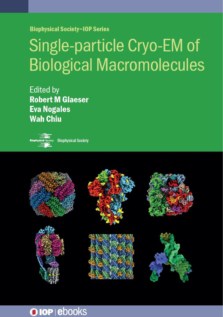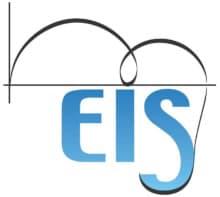A new ebook harnesses the knowledge and experience of more than 40 academic authors to provide a timely and comprehensive introduction to the technique of single-particle cryo-electron microscopy

For researchers entering a new field of study, or trying to get to grips with a new experimental approach, one of the most valuable resources is an up-to-date and comprehensive reference book. Unlike research papers or a review article, a book offers an expert synthesis of current best practice – allowing scientists to set up their experiments more quickly, obtain more reliable results, and understand how best to analyse and interpret their data.
One important example in structural biology is single-particle cryogenic electron microscopy, or cryo-EM, which since 2013 has enabled researchers to obtain high-resolution 3D structures of biological macromolecules. Pioneered by a small community of like-minded scientists with a background in biophysics, this powerful characterization technique is now becoming a popular tool in research studies ranging from biochemistry to cell biology.
“Many different people are coming into the field who don’t have previous training in single-particle cryo-EM,” comments Robert Glaeser of the Lawrence Berkeley National Lab (LBNL) in the US, who together with two co-editors and multiple expert authors has just published an ebook entitled Single-particle Cryo-EM of Biological Macromolecules. “They have a lot of details to learn about, and there was no single place for them to find the information they need.”
Many different people are coming into the field who don’t have previous training in single-particle cryo-EM.
Robert Glaeser
The big advantage of cryo-EM is that it offers a way to image macromolecules that are difficult or impossible to characterize using more established characterization techniques. For a start, it only requires a small amount of material to yield high-resolution structures, which makes it possible to study macromolecular complexes that are too scarce to provide the quantities needed for spectroscopic studies based on nuclear magnetic resonance. There is also no requirement to crystallize the sample, which can be a major barrier when attempting to characterize large protein complexes using X-ray crystallography.

What’s more, cryo-EM allows the macromolecule to be contained inside a biochemical buffer, which opens up the possibility of studying its biological function. “Macromolecular complexes have moving parts, they are a type of machine,” explains Glaeser. “They go through a catalytic cycle with many intermediate steps, and taking a picture with cryo-EM reveals all the steps in the process.”
The technique has advanced rapidly since 2013, when a new generation of cameras enabled the first high-resolution images to be captured. Since then the resolution of the technique has increased from 3.5 Å to better than 1.3 Å – enough to distinguish individual atoms in the structure. As a result, tens of thousands of macromolecular complexes have now have been imaged with cryo-EM, and its importance for biochemical studies was recognized by the 2017 Nobel prize for chemistry.
Early pioneers like Glaeser and his co-authors have been immersed in developing the technology for three decades or more, gradually accumulating the knowledge and understanding that comes from testing new ideas and learning from mistakes. But newcomers to the field can easily get confused by the methods used to gather and process the data. “They know the value of having a high-resolution structure, but it can be hard for them to figure out the concepts and approaches used in cryo-EM,” Glaeser comments.
There is still a lot of value in having an authoritative textbook on a subject rather than forcing people to dig back into the literature.
Robert Glaeser
An academic reference book was seen by many people in the biophysics community as the best way to fill this gap in knowledge and skills. The Biophysical Society, as part of its publishing partnership with IOP Publishing, sought authors for an ebook on the topic – which has the additional advantage making all the content easily accessible online. “There is still a lot of value in having an authoritative textbook on a subject rather than forcing people to dig back into the literature,” comments Glaeser. “It makes it easier for people who are coming into the field, particularly for postdocs and early-career scientists.”
The problem, says Glaeser, was finding an author. “Writing a book is a huge amount of work,” he points out. “My academic colleagues are generally too busy to write a chapter, let alone a complete book.”
Fortunately, Glaeser came up with the idea of producing an edited volume that brings together the expert knowledge of multiple authors. Together with two co-editors, Wah Chiu at Stanford University and Eva Nogales at LBNL, he invited a number of leading academics to write individual sections of book, each one about 3000 words long. “We asked people to write about the topic they know best,” he says. “That made it easy for them to compose the text, put the figures together, and select the most relevant references.”
The response was overwhelmingly positive. Just about everyone who was asked to write a section accepted the invitation. “The first ones to say yes were some of the busiest and most prominent people in the field,” says Glaeser. “They are often the toughest people to get to write, but obviously the need for the book was something that resonated with them.”
The big challenge for the three editors was to ensure that a book composed of some 35 individual contributions would come together as a coherent whole. Although there are plenty of research monographs that collect together articles from different authors, their aim was to create a practical reference book with a logical structure and a single voice.
Glaeser, Chiu and Nogales started by mapping out a detailed outline for the chapters, as well as for all the individual sections. From that they decided who would be the best author to write each individual section. “We know most of the people really well, so we had a good idea of what they were likely to write,” says Glaeser. “We might have made suggestions of what should be covered in each section, and provided a few guidelines, but for the most part we didn’t need to direct them. ”
Glaeser also took the time to read and edit each individual contribution. “It sounds like a lot of work, but it really wasn’t,” he says. “It helped to make it a book rather than a collection of articles, plus I learnt as much from my detailed reading of each section as the intended readers.” The result is an ebook that provides a comprehensive, accessible and authoritative introduction to cryo-EM. As well as clear explanations of the underlying concepts, it offers a practical guide to the key steps of sample preparation, data collection and analysis, and the final validation of results.
This multi-author model may be an unconventional approach to producing a book, but it offers several important benefits for both the authors and the readers. For a start, distributing the effort between many different contributors reduces the burden on any individual person – even for the three editors who took responsibility for managing the process and bringing the content together. “It was easy for me and my co-editors, and it was easy for each of the individual contributors,” comments Glaeser.
Distributing the work also speeds up the whole process. This particular ebook took just two years from initial proposal to final publication, while Glaeser says that another book he wrote with just a few co-authors took as long as 16 years. Such rapid publication ensures that all the content is up-to-date and relevant to present-day experiments, which makes the information much more useful to researchers who are learning to use the technique. It certainly seems to have found its mark, with almost 4000 chapter-downloads since the ebook was published in May 2021.
Perhaps most important, though, the book provides direct access to the knowledge and experience of multiple experts in the field. “What really makes the book work is the authoritative content provided by each of the section authors,” says Glaeser. “I don’t know everything, but I know the right authors and they do know everything. I really want to thank them for their selfless and whole-hearted participation. They are the ones who made this a success.”




